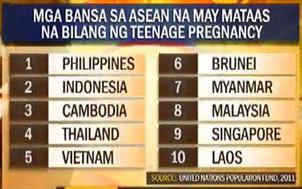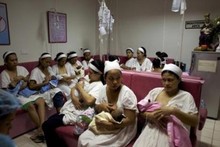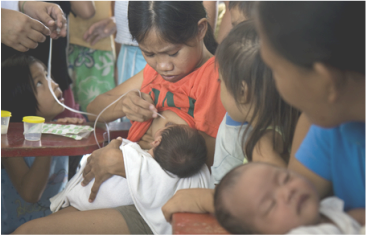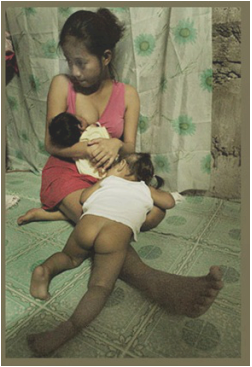
In
the Philippines, according to the 2002 Young Adult Fertility and
Sexuality Study by the University of the Philippines Population
Institute (Uppi) and the Demographic Research and Development
Foundation, 26 percent of our Filipino youth nationwide from ages 15 to
25 admitted to having a premarital sex experience. What’s worse is that
38 percent of our youth are already in a live-in arrangement.



TEENAGE PREGNANCY

Teenage pregnancy is the condition of being pregnant of adolescence
aged 10 to 19. Those who are affected are the girl herself up to the
national society. The victims of teenage pregnancy are the girl herself,
her child, her parents and relatives and the national society as a
whole. It will also probably make her economically vulnerable.
The national scope of the problem is alarming; the United Nation Population Fund Agency (UNPFC) representative Ugochi Daniels’ claims that this could derail the country’s Millennium Development Goals (MDGs). The Millennium Development Goals are eight international development goals that the UN member states have agreed to achieve by the year 2015. These MDG include eradicating extreme poverty and attaining universal primary education. In fact, among the six ASEAN major economies, the Philippines ranked the highest rate in teenage pregnancy.
The national scope of the problem is alarming; the United Nation Population Fund Agency (UNPFC) representative Ugochi Daniels’ claims that this could derail the country’s Millennium Development Goals (MDGs). The Millennium Development Goals are eight international development goals that the UN member states have agreed to achieve by the year 2015. These MDG include eradicating extreme poverty and attaining universal primary education. In fact, among the six ASEAN major economies, the Philippines ranked the highest rate in teenage pregnancy.
WHY IS IT A
PROBLEM IN OUR SOCIETY?
Teen pregnancy is a communal
problem, a family problem, and a personal problem all rolled into one. It
frequently goes hand in hand with premarital sex. Problems come when the news
needs to breach each parent’s party. A spring of thought flash before one’s
eyes, and registers only two; whether, to back the hell up – abort the child or
carry on with the pregnancy but sign up for adoption - or get the hell in –
have the child with all its perks and consequences alike.
After which, these impressions simply serve
no purpose but to put them off, and deduce to mere nuisance to them when the
truth of their situation slowly sinks in. How do they provide for the child if
their parents cut them short financially? Will they be able to go to grad
school? What will become of their future? What will become of their child’s
future? By this time, they would have to contend with the pressures of
parenthood. Whitehall truly bother them in the long run is the reality of whether
or not they can fulfill their obligation as parents, and the security of their
child’s future. Teenage pregnancy is becoming a societal problem that branches
out to other problems.
HISTORY AND
STATISTICS OF TEENAGE PREGNANCY IN THE PHILIPPINES.

One of the reasons why teenagers are already aware with this
topic is because of media. They get a higher knowledge to sex from the
magazines, TV shows, internet, movies and other media. In television, they now
also create and make shows about teen pregnancy like “Teen Moms” and “16 and
Pregnant”.
These shows make us realize that the rate of this problem is getting
higher and it is getting usual. There are a lot of reported cases regarding
teenage pregnancy since the past few years until now.
According to the UN Population Fund (UNFAIR),
teenage pregnancy has a huge rate in the Philippines, especially among the
poor. 2/3 of Filipinos, who give birth before age 20, belongs to the low class
society.
Data from the National Statistics Office showed that 8 percent among
1.7 million babies born in 2004 were born to mothers 15-19 years old. Young
mother gave birth to 818,000 babies in 2000 alone. This means, almost one of
every 10 babies is born to teenage mothers. The risk is, almost 10 percent of the
born babies from young mothers are malnourished. As years passed by, the
statistics are getting higher.
According to the study done by the Population
Institute of the University of the Philippines, more than 46 percent of teenage
pregnant woman resort to induced abortion which is against the law and the
Church; 2 of every 5 teenage pregnancies are unwanted ones. If the government
won’t start acting on this, this problem will be worse as years goes by.
WHAT SOCIAL FACTORS INSTIGATE TEENAGE PREGNANCY IN OUR COUNTRY?
In
the developed world, the causes of teenage pregnancy is different in
the sense that it is mostly outside marriage and carries lots of social
stigma. Thus, adolescent sexual behavior is one of the causes of teenage
pregnancy. In our world today, having sex before 20 yrs is the “in”
thing, it is even normal all over the world and this is brought about
high levels of adolescent pregnancy which creates sexual relationship
among teenagers without the provision of comprehensive information about
sex.
CONSEQUENCES OF TEENAGE PREGNANCY IN SOCIETY
a)
The issue of teenage pregnancy has several consequences. It is
continually increasing the population growth rate in the society. Many
babies are being born through it, which cannot be catered for by the
available resources.
b) The issue encourages dropping out from schools. Many pregnant female children end up dropping out from school to avoid shame thus undermining government's efforts towards ensuring Education for All and the Millennium Development goal of Education in the nearest future.
c) Due to poverty, many of those involved in teenage pregnancy die off prematurely because of lack of proper medical attention.
According to the CDC, children born to teenage mothers have an effect on society as well. These babies are more likely to rely on public health care throughout their lives and because they also have more chronic medical conditions, this places a higher burden on the health system.
b) The issue encourages dropping out from schools. Many pregnant female children end up dropping out from school to avoid shame thus undermining government's efforts towards ensuring Education for All and the Millennium Development goal of Education in the nearest future.
c) Due to poverty, many of those involved in teenage pregnancy die off prematurely because of lack of proper medical attention.
According to the CDC, children born to teenage mothers have an effect on society as well. These babies are more likely to rely on public health care throughout their lives and because they also have more chronic medical conditions, this places a higher burden on the health system.

ARE THERE LAWS ADDRESSING THIS PROBLEM? DOES IT OR DOES IT NOT HELP?
There are no specific laws that address the growing problem of teenage
pregnancy in our country; not only in our country but worldwide. This
cannot be prevented since it is the decision of the couple. One cannot
simply tell a couple to not “do the deed” or have sex since they
themselves are capable of voicing opinions out.
The following laws are implemented to address the social issue of
teenage pregnancy in the Philippines; not directly but is connected to
that topic as well: the RH Bill which includes sex education and the use
of contraceptives--- and that’s about it. This tells us several things:
firstly, there are not enough laws that address teenage pregnancy since
it is really difficult to monitor it. Secondly, this social issue
cannot be prevented with the help of laws since people cannot be
controlled in their decisions. And thirdly, this is a social issue that
continues everywhere and not even government officials or politicians
know how to control it.
RECOMMENDATIONS
Sex education can reach teenagers through many different ways, one of
which is through schools. The government can make it compulsory for
school students to undergo at least a certain number of hours of sex
education. Instead of focusing on the dangers and consequences of
teenage pregnancy, schools can also educate teenagers on the advantages
of not having a baby when they are unprepared so that students may be
able to weigh out the pros and the cons. This can be enforced by getting
students to attend service learning trips and having them be exposed to
the real world of teenage pregnancy.
Another way that teenagers can be educated about sex is through their parents but in order for this to work, there must be a strong relationship between the child and the parent. Also with a strong relationship, parents can have more influence in their child’s sex decisions and may be able to direct their decisions in the right way. So in other words, having a good parent-child relationship can help to decrease the affected population.
Another way that teenagers can be educated about sex is through their parents but in order for this to work, there must be a strong relationship between the child and the parent. Also with a strong relationship, parents can have more influence in their child’s sex decisions and may be able to direct their decisions in the right way. So in other words, having a good parent-child relationship can help to decrease the affected population.
source: http://youthproblemsinthephilippines.weebly.com/teenage-pregnancy.html


No comments:
Post a Comment